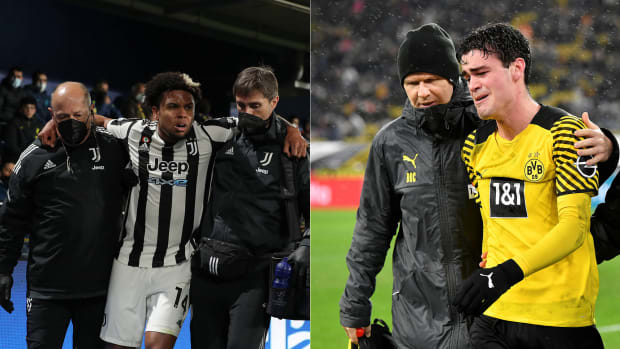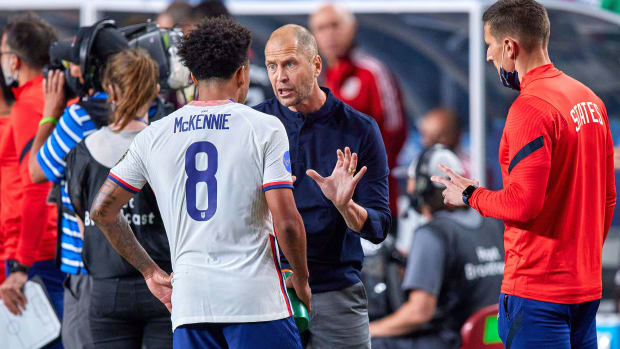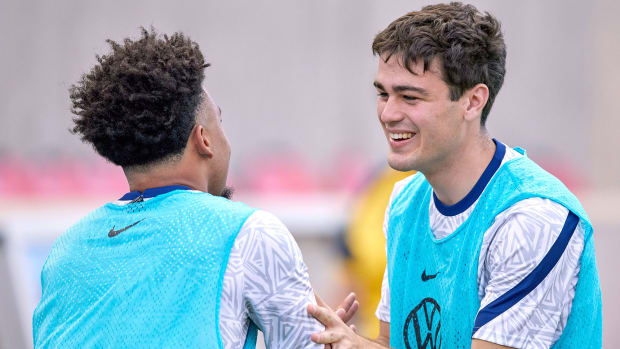On a dour day at Borussia Dortmund—there’s a big-picture crisis to the east in Ukraine and some short-term disappointment following Thursday’s Europa League loss to Rangers—managing director Carsten Cramer took note of Gio Reyna’s brightened demeanor as they crossed paths at the club’s office.
The last time the world saw Reyna, the 19-year-old American was limping off the Westfalenstadion field in tears. That was Sunday. Five days later, Reyna’s devastation had been replaced by optimism and resolve.
“I just talked to him. For him, it must be the worst situation when it happened on the pitch,” Cramer told reporters moments later. “I’m really, really happy when I just jumped into the media room to see him smiling and to see that he’s more positive that it will take some more days, but definitely not that [much longer] than anyone expected.”
After missing five months with a lingering hamstring injury suffered while on U.S. national team duty—that’s an eternity for an eager teenage player—Reyna returned only to get hurt again during his first Bundesliga start since August. His immediate reaction was eminently understandable. But the prognosis isn’t grim.
“The fear of a serious thigh injury by offensive player Gio Reyna, thank God, did not materialize after detailed diagnostics,” BVB said Monday. “The team doctors assume that the American will be able to complete part of the team training again within 14 days.”
The Lord giveth and taketh away, and then giveth back, only to abruptly about-face and taketh something else. For all the work, commitment planning, science, analytics and investment poured into soccer at the highest level, it can still seem like fate or divine intervention (or mischief) plays a significant role in proceedings. And so Dortmund thanks God, Reyna endures the wild swing in emotions and U.S. national team coach Gregg Berhalter and his staff make peace with embracing the unknown.
“I think what we’ve learned is expect the unexpected. You never know who’s going to be available to be play in each game. You have got be willing to adapt,” Berhalter said last month. “Some of it we’re not going to be able to control.”

Imago Images (2)
So Berhalter must plan for late March’s World Cup qualifying climax, which will feature three difficult games with the highest stakes attached, knowing he’ll never be able to do it precisely. Maybe Reyna will make it. The player said Friday, “I’m pretty positive I’ll be able to go [national team camp] and … I’ll really give everything and I’ll make sure I’m there.”
But Weston McKennie won’t be when the U.S. gathers in Houston at the end of March (unless he’s a spectator). Expelled from camp during September’s opening qualifying window for violating pandemic protocols, the Juventus midfielder has rebounded to become Berhalter’s best player in recent months. McKennie, 23, has evolved into a symbol of this young U.S. squad’s maturation, not to mention the focus required to handle Concacaf’s traditional hazards. Now the American linchpin is out, lost to a broken foot suffered in Juve’s Champions League draw at Villarreal on Tuesday.
McKennie is expected to miss eight weeks with a pair of fractured metatarsals. Following the March qualifiers in Mexico, against Panama in Orlando and then at Costa Rica, the U.S.’s next chance to compete comes in June. At that point, the U.S. either will begin 2022-23 Concacaf Nations League play or if it winds up finishing fourth in World Cup qualifying, head to Qatar for an intercontinental playoff. The Americans are in second at 6-2-3, four points behind unbeaten Canada and four ahead of fourth-place Panama.
McKennie has become a front-to-back force for the U.S., dynamic and imposing in midfield and dangerous in the penalty area and on set pieces. He is a jack of all trades and master of most, and there is no like-for-like replacement. He’s a significant loss ahead of the national team’s biggest games in more than four years.
“First and foremost, our heart goes out to Weston and we are supporting him in every way possible as he starts the rehab process,” Berhalter said in a statement provided to Sports Illustrated. “Injuries are an unfortunate part of our sport and timing is never ideal. That said, our team has always had a next-man-up mentality, and we are confident that the current group will finish the job in World Cup qualifying.”

Robin Alam/Icon Sportswire/Imago Images
Mentality plays a role. The U.S. has proven pretty resilient and has avoided dropping points in consecutive matches since the Octagonal’s first two. And it has had just one truly bad game, the October defeat in Panama. Berhalter’s team eventually adjusted to McKennie’s absence during that first window and closed with a 4–1 win at Honduras. Reyna hasn’t played since. Star winger Christian Pulisic has been in and out of the lineup and in and out of form. Other important players like Tim Weah, Sergiño Dest and Zack Steffen have missed time. Josh Sargent and John Brooks faded. Ricardo Pepi and Yunus Musah arrived.
The key is striking the right balance between chemistry and depth. Different coaches have different approaches. Jurgen Klinsmann preferred churn and competition over cohesion and predictability. Berhalter has leaned toward the latter. He set the stage for qualifying last summer by splitting the player pool between most of his high-profile Europeans in the Nations League, and then a roster anchored by domestic and younger talent in the ensuing Gold Cup. That successful month together helped bring additional players up to speed with a system of play that’s complex by national team standards. If you’re going to employ more intricate passing and pressing patterns, you’re going to need men with the familiarity and comfort to execute. It means the pool can’t get too deep too quickly. Introducing another new face, no matter how promising or talented, into a foreign setup could be counterproductive in the crucible of qualifying.
“Our system is very difficult to learn,” midfielder Cristian Roldan acknowledged during the squad’s ad hoc December camp, adding that it could even be “complicated and nerve-wracking at times.
“Gregg is very analytical. He looks at every training session and every play,” Roldan said.
That’s why McKennie’s replacement, for lack of a better term, is more likely going to come from within. And it’ll probably vary from game to game. Taking something away from the Azteca is going to require something rather different than breaking down visiting Panama three days later. Getting midfielders Kellyn Acosta and Luca de la Torre significant minutes in last month’s win over Honduras could prove critical. Acosta may provide the coverage, defensive grit, ball-winning and set-piece delivery that could make a difference in Mexico City. And De la Torre demonstrated the skill and proactive instinct on the ball that might help unhinge Los Canaleros.
Roldan, Gianluca Busio and Sebastian Lletget are among the other experienced midfield stopgaps, and Brenden Aaronson or even a healthy Reyna, in a pinch, might fill in. McKennie’s absence obviously will be noticeable, but it’s survivable absent additional injuries or acts of God.

Robin Alam/Icon Sportswire/Imago Images
The outcome next month will indicate whether Berhalter struck that balance. There are tests across the field, including an intriguing one upfront. Pepi hasn’t scored since early October and is still trying to find his footing at FC Augsburg. Young Boys striker Jordan Pefok can’t stop scoring in Switzerland, but he hasn’t played for the U.S. since the first two qualifiers in September. The ability to adjust and find the right blend between form and familiarity will help determine the Americans’ World Cup destiny.
Reyna said he feels ready, and part of that is the connection that’s maintained by frequent contact with U.S. teammates and staff. Rehab can be lonely and isolating, and bonds inevitably fray when they're not reinforced daily on the field. But Berhalter and his staff try to maintain some control over the uncontrollable by simply staying in touch. Depending on U.S. Soccer’s relationship with a given club, national team doctors can play a role in coordinating a player’s recovery plan. The federation’s ties with Juventus are good, and Berhalter characterized its response to McKennie’s injury as “instantaneous.” U.S. Soccer reached out to Juventus before its game was even over, and Berhalter spoke with McKennie that night.
Reyna said that steady communication has helped him endure the past few months and keep him in the qualifying loop.
“It’s hard not being there with them. Obviously, we have such a tight team. We all get along really well together. We’re also all very close to the staff just as a unit. Not just players, but as a staff—coaches, physios, athletic coaches, all the way down,” he said Friday.
“We’re all really close, so if I want to know the lineup before the game, I ask one of them. Or if I want to talk about the game, I can ask someone else. And in terms of Gregg, we’ve kept in touch quite often. You know we have a connection that goes farther than just playing,” he added, referencing a relationship with Berhalter and his family that began when the U.S. coach and Gio’s father, Claudio Reyna, were high school teammates in New Jersey.
“We’re really close and I’m really looking forward to hopefully being able to go into the next camp and yeah, being able to go to the World Cup,” Reyna said. “I’m going to speak with the people [at Dortmund] and speak with, obviously, Gregg and the people from the national team too. But I don’t really have too many worries that I won’t be able to go to the national team. I’m pretty positive I’ll be able to go.”
Hence the smile and a happier disposition. Tears are shed, then it’s time to get back to work. As McKennie exits, temporarily, perhaps Reyna will be reintroduced at last. Those ups and downs and ins and outs are an ingrained, permanent and predictable aspect of international soccer, but that makes them no less dramatic or impactful. Solving that puzzle on game day is part of the test, and the Americans’ final exam is a month away.







